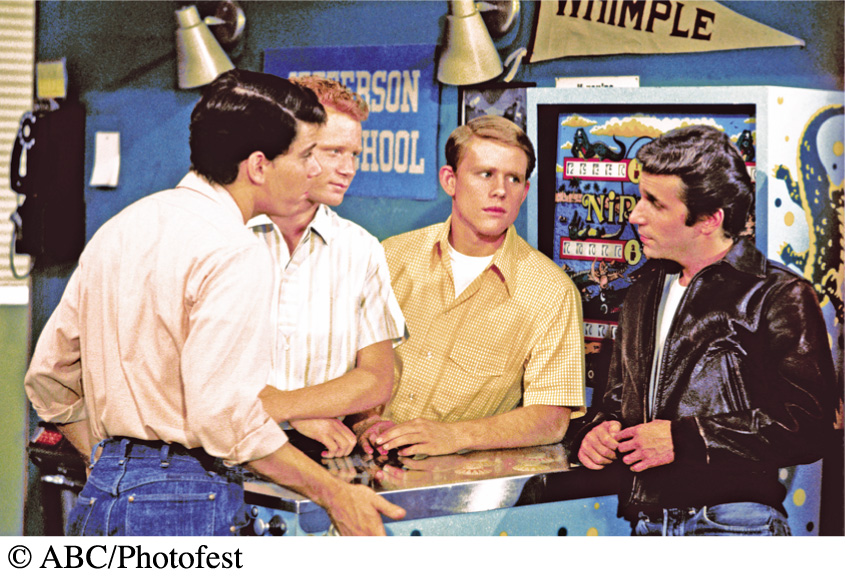MEDIA LITERACY Case Study: The Effects of Television in a Post-TV World
MEDIALITERACYCase StudyThe Effects of Television in a Post-TV World
Since television’s emergence as a mass medium, there has been persistent concern about the effects of violence, sex, and indecent language seen in television programs. The U.S. Congress had its first hearings on the matter of television content in 1952 and has held hearings in every subsequent decade. In its coverage of congressional hearings on TV violence in 1983, the New York Times accurately captured the nature of these recurring public hearings: “Over the years, the principals change but the roles remain the same: social scientists ready to prove that television does indeed improperly influence its viewers, and network representatives, some of them also social scientists, who insist that there is absolutely nothing to worry about.”1

macmillanhighered.com/mediaessentials3e

 Visit LaunchPad to watch a clip from 2 Broke Girls, one of the Parents Television Council’s least favorite shows. Do you find anything about it objectionable?
Visit LaunchPad to watch a clip from 2 Broke Girls, one of the Parents Television Council’s least favorite shows. Do you find anything about it objectionable?

One of the central focuses of the TV debate has been television’s effect on children. In 1975, the major broadcast networks (then ABC, CBS, and NBC) bowed to congressional and FCC pressure and agreed to a “family hour” of programming in the first hour of prime-time television (8–9 P.M. Eastern, or 7–8 P.M. Central). Shows such as Happy Days and Little House on the Prairie flourished in that time slot. By 1989, Fox had arrived as a fourth major network and successfully counterprogrammed in the family hour with daringly dysfunctional family shows like Married … with Children.
Since then, the most prominent watchdog monitoring prime-time network television’s violence, sex, and indecent language has been the Parents Television Council (PTC), formed in 1995. As part of its primary mission, the lobbying group “promotes and restores responsibility and decency to the entertainment industry in answer to America’s demand for positive, family-oriented television programming. The PTC does this by fostering changes in TV programming to make the early hours of prime time family-friendly and suitable for viewers of all ages.”2 Through its Web campaign of inundating the FCC with complaints, the PTC played a leading role in getting the FCC to approve a steep increase in its fines for broadcast indecency.
505
Yet for the ongoing concerns of parent groups and Congress, it’s worth asking: What are the effects of television in what researchers are now calling a “post-TV” world? In just the past few years, digital video recorders have become common, and services like Hulu, YouTube, Netflix, iTunes, and on-demand cable viewing mean that viewers can access TV programming of all types at any time of the day. Although Americans are watching more television than ever before, it’s increasingly time-shifted programming. Should we still be considering the possible harmful effects of prime-time network television, given that most American families are no longer watching during the appointed broadcast network prime-time hours? Does the American public care about such media effects in this post-TV world?
These days, the PTC still releases its weekly “Family Guide to Prime Time Television” on its Web site. A sample of the guide from summer 2014, for example, listed no shows as being “family friendly,” while shows as diverse as The Big Bang Theory, Person of Interest, America’s Got Talent, and Arrow received a red-light designation for sexual content, language, and violence. Of course, as television viewers move away from broadcast networks and increasingly watch programming from multiple sources on a range of devices, the PTC’s traditional concern about prime-time network viewing can seem outdated. In May 2012, the PTC announced it was awarding its seal of approval to the Inspiration Network cable channel “for programming that embraces time-honored values.”3 The channel’s lineup features shows like The Waltons; Dr. Quinn, Medicine Woman; Little House on the Prairie; and Happy Days—all shows from an era decades before our post-TV world.
APPLYING THE CRITICAL PROCESS
DESCRIPTION Keep track of your TV viewing habits for one week. Devise a chart and create categories for the types of shows you watch (sitcoms, dramas, reality programs), how you watch each show (on television, laptop, smartphone), and if you are watching the shows when aired or are time-shifting in some way. If you are time-shifting, what time is it normally aired, and on what network or from what source?
ANALYSIS Take note of the content of each program—what topics are covered, and whether or not there is violence. What shows seem to feature more violence than others, and what kind of violence? How much violence do you find overall?
INTERPRETATION What do your findings mean? Are you surprised by the appearance of violence in any seemingly nonviolent shows? Do broadcast network shows (on ABC, CBS, NBC, Fox, the CW) feature more, similar amounts of, or less violent programming than cable, satellite, or streaming-only television shows?
EVALUATION How does exposure to violence in these shows affect you? Do you agree with the FCC statement that “exposure to violence in the media can increase aggressive behavior in children, at least in the short term”? Why or why not?
ENGAGEMENT Aside from TV shows, examine other forms of entertainment that you enjoy, such as your collection of movies or video games, for the presence of violent content. Are the rating systems for these products effective? File your comments or concerns online with the FCC (www.fcc.gov).